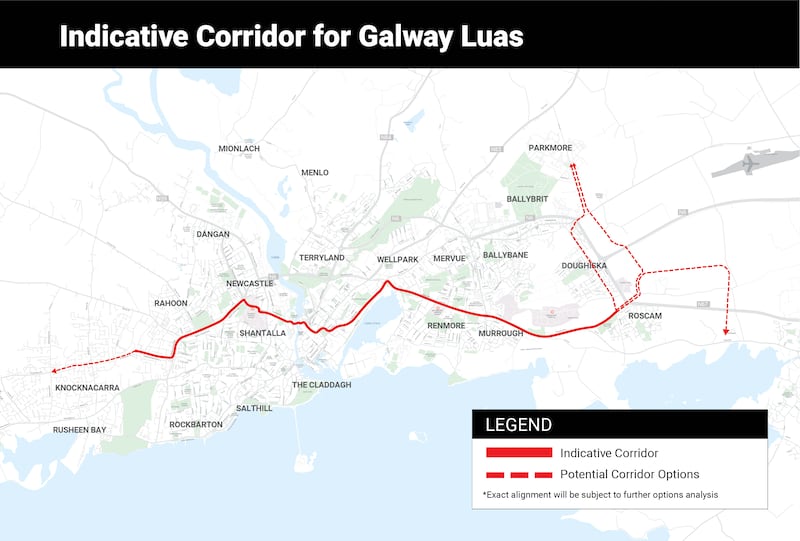A new feasibility study has said there is a case for developing a 15km light railway transit (LRT) corridor in Galway City.
The study commissioned by the National Transport Authority has concluded that the LRT route in Galway (locally referred to as Gluas) would reduce car trips by at least 10 per cent but would come at a high cost – between €1.23 billion and €1.34 billion in 2023 prices.
“The costs of the project will inevitably rise with future construction price inflation,” it says.
The 46-page report was prepared by consultant company Atkins-Réalis, which has international expertise in transport. It looked at four possible corridors and said the most preferable option was a 14.8km route that went from the suburb of Knocknacarra in the West of the city to Eyre Square and then to the eastern suburbs of Parkmore and Doughiska.
READ MORE
It said that if park-and-ride facilities were available at the termini on each side, the LRT could serve commuters from Connemara in the West, and from Oranmore, Athenry and other commuting town on the east.
It also said that such a route would pass by the city’s busiest locations including University Hospital, the University of Galway, the city centre, and the industrial and business parks on the east of the city.

The daily passenger demand at peak hours could reach 1,800 per hour travelling from the western suburbs, and 1,500 per hour travelling from the eastern side of the city. Demand would fall to about 500 per hour during offpeak hours. The overall demand, according to the more optimal models, could reach 7.5 million passengers per year.
The report set out two options in terms of the type of transport: conventional LRT as in Dublin, or Very Light Rail (VLR), a system that uses small and very light trams with a maximum capacity of 70.
In any instance it concludes Galway will not need long trams. “There is unlikely to be a need in Galway for such long trams, and manufacturers are also able to offer smaller configurations to meet the needs of smaller cities or less busy routes.
“For example, in Frankfurt, there was a recent new order for 31.5m long trams with capacity up to 190 passengers,” it said.
VLR systems do not rely on a catenerary system (overhead electrical cables) but each locomotive can be powered by rechargeable battery. In addition, the ground works involved with very light rail are less intrusive, go to less depth, and do not require underground utilities to be moved. The construction costs are far lower than for LRT. A Very Light Rail system is being piloted in Coventry at present.
The narrow streets of the city centre would provide some challenges in terms of track-laying and the Salmon Weir Bridge, if used, might need to be strengthened. The consultants add that several hills in Galway would require careful planning for a system that can negotiate a 10 per cent gradient.
If the line were to go through University Hospital, the report suggested an elevated structure to ensure it would not have an impact on traffic. That would necessitate 200 metre long ramps on either end.
Green Party senator Pauline O’Reilly, who has campaigned for a LRT for the city, responded to the report’s publication by saying that “Gluas” would transform Galway.
“What’s really interesting about this feasibility study is that it also tells us that Gluas would work best and would benefit an even greater number of people if we also accelerated all the other sustainable transport plans we need to really get Galway moving,” said Senator O’Reilly.
Independent TD for Galway West Catherine Connolly said the report now provides a pathway toward making light rail a reality for Galway and the people of Galway.
“After many years of campaigning on this issue with dedicated people on the ground, today marks a significant step towards bringing sustainable, accessible transit solutions to Galway.
“Investing in public transport infrastructure like light rail will bring lasting environmental, social and economic benefits and, crucially, will help the people of Galway by significantly reducing congestion, something we have been calling for over many years.”
- Sign up for push alerts and have the best news, analysis and comment delivered directly to your phone
- Join The Irish Times on WhatsApp and stay up to date
- Listen to our Inside Politics podcast for the best political chat and analysis














